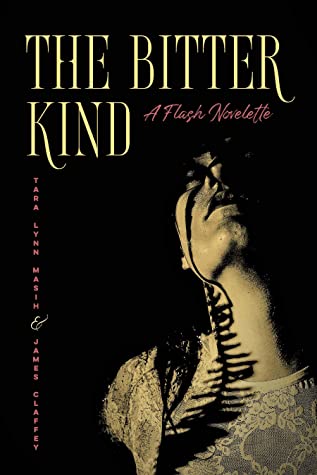
by Kara Oakleaf
So many of us are overwhelmed by isolation right now. Whether we’re slowly reentering an altered world after months in quarantine, or still hiding away in the safety of our own homes while waiting to see what comes next, this is a year when people across the globe have been thrown into a new kind of loneliness.
Maybe this is why I was so immediately drawn to the characters at the center of Tara Lynn Masih and James Claffey’s collaborative flash novelette, The Bitter Kind (Červená Barva Press, 2020). Stela, the daughter of a ship’s captain, and Brandy, a boy orphaned early in life, grow up under very different circumstances – Stela in Alabama and desperate to get away from her abusive father, Brandy in the mountains and valleys of Montana, already out of place as the son of a Cree mother and a white father and feeling even more separated from any sense of home after his parents’ deaths. In brief, alternating flashes, the story moves between the two characters, following them from childhood into their adult lives, and while their stories don’t converge until the end, the characters feel united in that they are both profoundly, achingly lonely.
Despite years of abuse, Stela is a hopeful character – she senses there might be something better out in the world for her. When her father is away at sea, “there’s an expansion that takes place in her, as if she’s coming out of a tight hiding space and retaking her original shape” (5). She pursues this feeling through multiple failed relationships, and though she is able to put distance between herself and her family, she is haunted by the abuse she endured from her father. The Captain always seems present in her relationships – he’s in the scent of one partner’s hair, a warning she doesn’t heed, or in the way another “buries Stela under a mountain of insults” (36). After a childhood spent dreaming about escaping her father, Stela finds herself fleeing from these relationships as well, packing up and leaving before the men suspect she’ll be gone.
From the beginning, Brandy is defined against the backdrop of the natural world – he is haunted by the spirit of a wolf killed the night he was born and when he goes out into the forest with his father who works for a lumber company, he “can hear the trees crying and moaning. They aren’t dead like gold. They live… Brandy has to squint from the painful cries echoing in his ears” (12). Like Stela, he fails to build a new family and loses his most significant relationship when he realizes his wife is simply not coming back from a girls’ night out.
Where Stela is haunted by her own memories, Brandy’s haunting is more literal – the ghost wolf he identifies with so strongly sometimes follows him; other times it seems to abandon him as he loses parts of himself. Later in life, he lives and works in ghost-town-turned-tourist-attraction. Here, he “roams the dirt streets and wooden boardwalks. Hops the acrylic barriers. Tries on hats, pokes around in old tobacco containers and pipes, continues the game of solitaire left unfinished on the saloon table. Takes his dinner of scrambled eggs or stew to the fancy house and eats at a mahogany table set for twelve, or to one of the cabins and eats at a wooden table set with a humble bread board and pewter pitcher” (42). The images of Brandy moving through this abandoned town are eerie, almost as if he himself is haunting it. And it is in this town that he encounters more ghosts, ones he feels less certain about than his old familiar ghost wolf.
One of the strongest parts of the book is how these supernatural elements are incorporated, because so much of it feels grounded in realism. Stela and Brandy’s stories are both stories of place – Stela’s “beloved Black Warrior River and water oaks,” the “leafy waterways,” the “bleak expanse of the Gulf Coast” (5), and “shards of frost like broken glass on the ground” (34) in Alabama. And in Brandy’s Montana, there’s the mountain range that shares its name with his mother, the aspen leaves that “glitter like round spheres in the sun” (11), the “rocky, brush-covered face of a terrain that requires more thought to walk and live on” (25), and “blue-white ice clutching river rocks” (27) along the Missouri river. These sharp, rich landscapes grounded in detail and realism are so vividly imagined that I didn’t stop to question the appearance of a ghost wolf’s paw prints around a campfire (27) or the specter of a long-dead woman in the middle of a ghost town’s schoolhouse (43). The supernatural is ingrained in the realism of the landscape, and Masih and Claffey somehow make the ghosts feel as natural as the Montana mountains or the Alabama waterways.
For a short novelette, The Bitter Kind tells an expansive story. The decades-long time frame, beginning in 1942 and ending in 1982, feels like it could be more suited to a longer form, a sprawling, lengthy novel. But Masih and Claffey zero in closely on the most striking moments of Stela and Brady’s lives, capturing entire marriages in a few keenly observed paragraphs and long journeys in the space of a sentence. The characters each hold the kind of weight that could sustain a much longer piece, but feel fully realized and sharply focused here.
And it’s not hard to imagine these stories separately – it’s not until the end that they merge, and the moment the stories are finally brought together in the final scene, the passages now quickly switching between the two characters’ perspectives in a kind of duet, brings both of their stories to an intense, fast-paced and breathless conclusion. These are characters who could sustain their own stories, but the way their lives finally converge offers each of them a surprising moment of resolution. In these two characters, Masih and Claffey have given us something that feels so essential right now – one of those rare stories that makes you feel a little less alone.
________________________
 Kara Oakleaf‘s work has appeared in Booth, Matchbook, SmokeLong Quarterly, Wigleaf, Pithead Chapel, and elsewhere. Her short stories have been selected for The Best Small Fictions and the Wigleaf Top 50, and appear in the Bloomsbury anthology Short-Form Creative Writing. She received her M.F.A. at George Mason University, where she now teaches writing and literature, and directs the Fall for the Book literary festival. She tweets @karaoakleaf.
Kara Oakleaf‘s work has appeared in Booth, Matchbook, SmokeLong Quarterly, Wigleaf, Pithead Chapel, and elsewhere. Her short stories have been selected for The Best Small Fictions and the Wigleaf Top 50, and appear in the Bloomsbury anthology Short-Form Creative Writing. She received her M.F.A. at George Mason University, where she now teaches writing and literature, and directs the Fall for the Book literary festival. She tweets @karaoakleaf.

 A SmokeLong Summer 24!
A SmokeLong Summer 24!